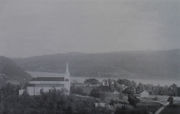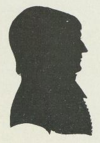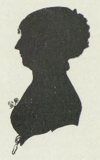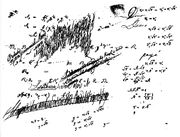Niels Henrik Abel
| Niels Henrik Abel | |
|---|---|
 Niels Henrik Abel
|
|
| Born | August 5, 1802 Nedstrand, Norway |
| Died | April 6, 1829 (aged 26) Froland, Norway |
| Residence | Norway |
| Nationality | Norwegian |
| Fields | Mathematics |
| Alma mater | Royal Frederick University |
| Known for | Abelian function Abelian group Abel's theorem |
| Influences | Bernt Michael Holmboe |
Niels Henrik Abel (5 August 1802 – 6 April 1829) was a noted Norwegian mathematician[1] who proved the impossibility of solving the quintic equation in radicals.
Contents |
Life
Early life



Niels Henrik Abel was born in Nedstrand, Norway, as second child to Søren Georg Abel and Anne Marie Simonsen. When he was born, the family was living at the rectory at Finnøy. Much suggests that Niels Henrik was born in the neighboring parish, as his parents were guests of the bailiff in Nedstrand in July / August of his year of birth.[2][note 1]
Niels Henrik Abel's father, Søren Georg Abel, had a degree in theology and philosophy and served as pastor at Finnøy. Søren's father, Niels's grandfather, Hans Mathias Abel, was also a pastor, at Gjerstad near Risør. Søren had spent his childhood at Gjerstad, and had also served as chaplain there; and after his father's death in 1804, Søren was appointed pastor at Gjerstad and the family moved there.
Anne Marie Simonsen was from Risør; her father, Niels Henrik Saxild Simonsen, was a tradesman and merchant ship-owner, and said to be the richest person in Risør. Anne Marie had grown up with two step-mothers, in relative luxurious surroundings. At Gjerstad rectory, she enjoyed arranging balls and social gatherings. Much suggests she was early on an alcoholic and took little interest in the upbringing of the children.[2] Niels Henrik and his brothers were given their schooling by their father, with handwritten books to read. Interestingly, an addition table in a book of mathematics reads: 1+0=0.[2]
Cathedral School and Royal Frederick University
With Norwegian independence, and first election held in Norway, in 1814, Søren Abel was elected as a representative to the Storting. Meetings of the Storting were held until 1866 in the main hall of the Cathedral School in Christiania (now known as Oslo). Almost certainly this is how he came into contact with the school, and he decided that his eldest son, Hans Mathias, should start there the following year. However, when the time for his departure approached, Hans was so saddened and depressed over having to leave home that his father did not dare send him away. He decided to send Niels instead.[2]
Thus it was that, in 1815, Niels Abel entered the Cathedral School, aged 13. In the event his elder brother Hans joined him there a year later. They shared rooms, and had classes together. In general, Hans got better grades than Niels; however, a new mathematics teacher, Bernt Michael Holmboe, was appointed in 1818. He gave the students mathematical tasks to do at home. He saw Niels Henrik's talent in mathematics, and so encouraged him to study the subject to an advanced level. He even gave Niels private lessons after school.
In 1818, Søren Abel had a public theological argument with Stener Johannes Stenersen regarding his catechism from 1806. The argument was well covered in press. Søren was given the nickname "Abel Treating" (Norwegian: "Abel Spandabel"). Niels reaction to the quarrel was said to be "excessive gaiety". At the same time his father Søren also almost faced impeachment, after insulting Carsten Anker, the host of the Norwegian Constituent Assembly; and in September 1818 he returned to Gjerstad with his political career in ruins. He began drinking heavily and died only two years later (in 1820), aged 48. At his funeral, with the rectory full of guests, the widow Anne Marie Abel got drunk and went openly to bed with one of the servants.[2][note 2]
The two brothers reacted differently to the decline of their family. At school, Niels Henrik did extremely well in mathematics, though he struggled in other subjects. Hans Mathias, on the other hand, went into a serious depression, never to recover: he had quit school and returned to Gjerstad shortly before their father died. The family was left in strained circumstances. Anne Marie Abel's once-rich father had also faced decline. He went bankrupt in a recession after the Napoleonic Wars, and died also in 1820.[2]
Bernt Michael Holmboe supported Niels Henrik Abel with a scholarship to remain at the school and raised money from his friends to enable Abel to study at the Royal Frederick University.
Abel entered the university in 1821. He was already the most knowledgeable mathematician in Norway. Holmboe had nothing more he could teach him and Abel had studied all the latest mathematical literature in the University library. Abel had also started work on his first achievement, the quintic equation in radicals. Abel initially thought he had found the solution to the quintic equation in radicals in 1821. Mathematicians had been looking for a solution on this problem for over 250 years. The two professors in Christiania, Søren Rasmussen and Christopher Hansteen, found no errors in Abel's formulas, and sent the work on to the leading mathematician in the Nordic countries, Professor Ferdinand Degen in Copenhagen. He also found no faults, but still doubted that the solution, which so many outstanding mathematicians had sought for so long, could now really have been found by an unknown student in far-off Christiania. Degen noted, however, Abel's unusually sharp mind, and believed that such a talented young man should not waste his abilities on such a "sterile object" as the fifth degree equation, but rather on elliptic functions and transcendence; for then, writes Degen, he will "discover Magellanian thoroughfares to large portions of a vast analytical ocean".[2] Degen asked Abel to give a numerical example of his method and, while trying to provide an example, Abel discovered a mistake in his paper.[3]
Abel graduated in 1822. His performance was medium, except in mathematics.
Career

After he graduated, professors from university supported Abel financially, and Professor Christopher Hansteen let him live in a room in the attic of his home. Abel would later view Ms. Hansteen as his second mother. While living here, Abel helped his younger brother, Peder Abel, through to examen artium. He also helped his sister Elisabeth to find work in the town.
In the spring of 1823, Niels Abel published his first article in "Magazin for Naturvidenskaberne", Norway's first scientific journal, which had been co-founded by Professor Hansteen. Abel published several articles, but the journal soon realized that this was not material for the common reader. In 1823, Abel also wrote a paper in French. It was "a general representation of the possibility to integrate all differential formulas" (Norwegian: en alminnelig Fremstilling af Muligheten at integrere alle mulige Differential-Formler). He applied for funds at the university to publish it. However the work was lost, while being reviewed, never to be found thereafter.[2]
In the summer of 1823, Professor Rasmussen gave Abel a gift of 100 speciedaler so he could travel to Copenhagen and visit Ferdinand Degen and other mathematicians there. While in Copenhagen, Abel did some work on Fermat's Last Theorem. Abel's uncle, Peder Mandrup Tuxen, lived at the naval base in Christianshavn, Copenhagen, and at a ball there Niels Abel met Christine Kemp, his future fiancée. In 1824, Christine moved to Son, Norway to work as a governess and the couple got engaged over Christmas, 1824.[2]
After returning from Copenhagen, Abel applied for a government scholarship in order to visit top mathematicians in Germany and France; but instead, he was granted 200 speciedaler yearly for two years, to stay in Cristiania and study German and French. In the next two years, he was promised a scholarship of 600 speciedaler yearly and he would then be permitted to travel abroad.[2] While studying these languages, Abel published his first notable work in 1824, Mémoire sur les équations algébriques où on démontre l'impossibilité de la résolution de l'équation générale du cinquième degré (Memoir on algebraic equations, in which the impossibility of solving the general equation of the fifth degree is proven). For, in 1823, Abel had at last proved the impossibility of solving the quintic equation in radicals (now referred to as the Abel–Ruffini theorem). However, this paper was in an abstruse and difficult form, in part because he had restricted himself to only six pages, in order to save money on printing. A more detailed proof was published in 1826 in the first volume of Crelle's Journal.
In 1825, Abel wrote a personal letter to King Carl Johan of Norway/Sweden requesting permission to travel abroad immediately. He was granted this permission, and in September 1825 he left Christiania together with four friends from university (Christian P.B Boeck, Balthazar M. Keilhau, Nicolay B. Møller and Otto Tank). The four were traveling to Berlin and to the Alps to study geology. Abel wanted to follow them to Copenhagen and from there make his way to Göttingen. The terms for his scholarship was that he was to visit Gauss in Göttingen and then continue to Paris. However, when he got as far as Copenhagen he changed his plans. He wanted to follow his friends to Berlin instead, intending to visit Göttingen and Paris afterwards.[2]
On the way, he visited the astronomer Heinrich Christian Schumacher in Altona, now a district of Hamburg. He then spent four months in Berlin, where he became well acquainted with August Leopold Crelle, who was then about to publish his mathematical journal, Journal für die reine und angewandte Mathematik. This project was warmly encouraged by Abel, who contributed much to the success of the venture. Abel contributed seven articles to it in its first year.
From Berlin Abel also followed his friends to the Alps. He went to Leipzig and Freiberg to visit Georg Amadeus Carl Friedrich Naumann and his brother the mathematician August Naumann. In Freiberg Abel did brilliant research in the theory of functions, particularly: elliptic, hyperelliptic, and a new class now known as abelian functions.
From Freiberg they went on to Dresden, Prague, Vienna, Trieste, Venice, Verona, Bolzano, Innsbruck, Luzern and Basel. July 1826 Abel traveled on his own from Basel to Paris. Abel had sent most of his work to Berlin to be published in Crelles Journal, but he had saved what he regarded his most important work for the French Academy of Sciences, a theorem on addition of algebraic differentials. With the help of Johan Gørbitz he found an apartment in Paris and continued his work on the theorem. He finished in october 1826, and submitted it to the academy. It was to be reviewed by Augustin-Louis Cauchy. Abels work was scarcely known in Paris, and his modesty restrained him from proclaiming his research. The theorem was put aside and forgotten until his death.
Abel's limited finances finally compelled him to abandon his tour in January 1827. He returned to Berlin, and was offered a position as editor of Crelles Journal, but opted. By May 1827 he was back in Norway. His tour abroad was viewed as a failure. He had not visited Gauss in Göttingen and he had not published anything in Paris. His scholarship was therefore not renewed and he had to take up a private loan in Norges Bank of 200 spesidaler. He never repaid this loan. He also started tutoring. He continued to send most of his work to Crelles Journal. But in the summer of 1828 he published, in rivalry with C.G.J.Jacobi, an important work on elliptic functions in Astronomische Nachrichten in Altona.
Death
While in Paris, Abel had contracted tuberculosis. For Christmas 1828, he traveled by sled to Froland to visit again his fiancée. He became seriously ill on the journey and, although a temporary improvement allowed the couple to enjoy the holiday together, died just two days before a letter arrived from August Crelle. All this time, Crelle had been searching for a new job for Abel in Berlin, and had actually managed to have him appointed a professor at a university. Crelle wrote to Abel on 8 April 1829 to tell him the good news, but it came too late.
Mathematical work
At the age of 16, Abel gave a proof of the binomial theorem valid for all numbers, extending Euler's result which had only held for rationals. At age 19, he showed there is no general algebraic solution for the roots of a quintic equation, or any general polynomial equation of degree greater than four, in terms of explicit algebraic operations. To do this, he invented (independently of Galois) an extremely important branch of mathematics known as group theory, which is invaluable not only in many areas of mathematics, but for much of physics as well. Among his other accomplishments, Abel wrote a monumental work on elliptic functions which, however, was not discovered until after his death. When asked how he developed his mathematical abilities so rapidly, he replied "by studying the masters, not their pupils."[4] Abel said famously of Carl Friedrich Gauss's writing style, “He is like the fox, who effaces his tracks in the sand with his tail.”[5]
Legacy
The early death of this talented mathematician, of whom Adrien-Marie Legendre said "quelle tête celle du jeune Norvégien!" ("what a head the young Norwegian has"), cut short a career of extraordinary brilliance and promise. Under Abel's guidance, the prevailing obscurities of analysis began to be cleared, new fields were entered upon and the study of functions so advanced as to provide mathematicians with numerous ramifications along which progress could be made. His works, the greater part of which originally appeared in Crelle's Journal, were edited by Bernt Michael Holmboe and published in 1839 by the Norwegian government, and a more complete edition by Ludwig Sylow and Sophus Lie was published in 1881. The adjective "abelian", derived from his name, has become so commonplace in mathematical writing that it is conventionally spelled with a lower-case initial "a" (e.g., abelian group, abelian category, and abelian variety).
On 6 April 1929, four Norwegian stamps were issued for the centenary of Abel's death. His portrait appears on the 500-kroner banknote (version V) issued during 1978–1985. On 5 June 2002, four Norwegian stamps were issued in honour of Abel two months before the bicentenary of his birth. There is also a 20-kroner coin issued by Norway in his honour. A statue of Abel stands in Oslo, and crater Abel on the Moon was named after him. In 2002, the Abel Prize was established in his memory.
 Niels Henrik Abel on a Norwegian 500 kroner banknote, 1978 |
 Statue of Niels Henrik Abel in Oslo |
See also
- Abel transform
- Abel transformation
- Abel's identity
- Abel's inequality
- Abel equation
- Abelian group
- Abel's theorem
- Abelian means
Notes
- ↑ Peter Schnitler Marstrand was bailiff in Nedstrand from 1798 to 1809. His wife, Madam Anne Margrethe Marstrand, was one of ten sponsors at Abel's baptism. The other sponsors were from Finnøy. Niels Henrik was born premature and, according to oral tradition, a newly born child had to be washed in red wine and wrapped in cotton cloth in order to survive. Niels Henrik's father baptised him, and wrote in the parish register: "6 September 1802 baptized in Finnøy church the pastor Søren G. Abel and Ane Marie Simonsen's child, Niels Henrik, born 5th August" - (Norwegian: September 6te 1802 døbt i Findøe Kirke Sognepræsten Søren G. Abel og Ane Marie Simonsens Barn Niels Henrik, fød den 5te August.")
Source: Skadberg, Gunnar A.: Ætt og heim 2004, chapter 5, Sogneprest Søren Georg Abel - Matematikerens far. ISBN 82-90087-65-9
Morten Kiærulf was appointed pastor for Nedstrand in 1829. He wrote in a letter in 1880 to professor Bjerknes in Valle, that he was told by locals that one of Abel's sons was born at former bailiff Marstrand's house in Nedstrand.
Source: Myhre, Sigmar: Ætt og heim 2009, chapter 6, Niels Henrik Abel - fødestaden. ISBN 978-82-90087-72-7 - ↑ That same year, after receiving news of Søren Georg Abel's death, Peder Mandrup Tuxen wrote to his wife Marie Elisabeth Simonsen (who was Anne Marie Abel's sister):
Often I think of Anne Marie's peculiar character. I have always viewed her as phlegmatic and at least thought she had inferior passions. Well I remember from Finnøy, a handsome peasant, she may have liked and often talked to with great pleasure, but she seemed so cold to me, that I could not view this as nothing other than simple benevolence. Dark in front of me however, I have heard of another such inclination now.
(Norwegian: Ofte tænker jeg paa Anne Maries besyndelige Karakter. Jeg har altid anset hende for flagmatisk og mindst tiltænkt hende saa lave Lidenskaper. Vel mindes jeg fra Findøen, der var en smuk Bondekarl, hun godt kunde lide og hun talte ofte med ham med særdeles Fornøjelse, men hun forekom mig saa kold, at jeg ej kunde tage dette for andet end simpel Velvilje. Dunkelt staar imidlertid for mig, at jeg har hørt noget mere om en saadan Inklination.)
Source: Skadberg, Gunnar A.: Ætt og heim 2004, chapter 5, Sogneprest Søren Georg Abel - Matematikerens far. ISBN 82-90087-65-9
References
- ↑ Chambers Biographical Dictionary, ISBN 0-550-18022-2, page 3
- ↑ 2.00 2.01 2.02 2.03 2.04 2.05 2.06 2.07 2.08 2.09 2.10 Stubhaug, Arild: Niels Henrik Abel – utdypning (NBL-artikkel) - Store norske leksion
- ↑ http://www-groups.dcs.st-and.ac.uk/~history/Biographies/Abel.html
- ↑ http://scienceworld.wolfram.com/biography/Abel.html
- ↑ [|Simmons, George Finlay] (1992). Calculus Gems. New York: Mcgraw Hill. pp. 177. ISBN 0883855615.
Further reading
- Livio, Mario (2005). The Equation That Couldn't be Solved. New York: Simon & Schuster. ISBN 0743258215.
- Stubhaug, Arild (2000). Niels Henrik Abel and his Times. Trans. by Richard R. Daly. Springer. ISBN 3540668349.
External links
- From the Abel Prize website:
- Biography by Arild Stubhaug
- Scientific biography by Christian Houzel
- Collected works
- Handwritten manuscripts
- Memorabilia
- O'Connor, John J.; Robertson, Edmund F., "Niels Henrik Abel", MacTutor History of Mathematics archive, University of St Andrews, http://www-history.mcs.st-andrews.ac.uk/Biographies/Abel.html.
- Biography of Niels Henrik Abel
- Weisstein, Eric W., Abel, Niels Henrik (1802-1829) from ScienceWorld.
- Niels Henrik Abel at the Mathematics Genealogy Project
- Translation of Niels Henrik Abel's Research on Elliptic Functions at Convergence
- Famous Quotes by Niels Henrik Abel at Convergence
- The Niels Henrik Abel mathematical contest, The Norwegian Mathematical Olympiad